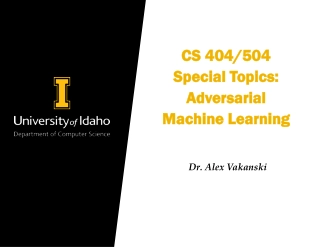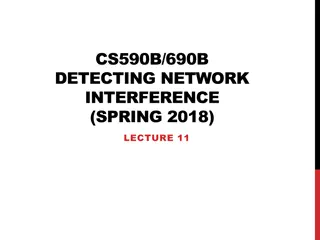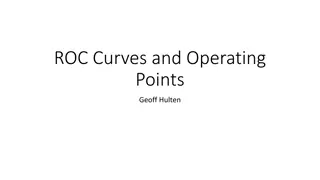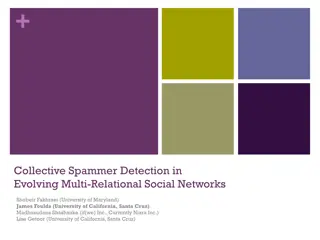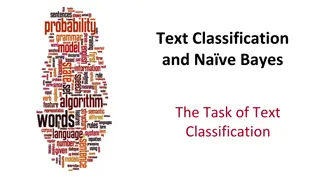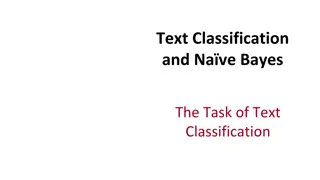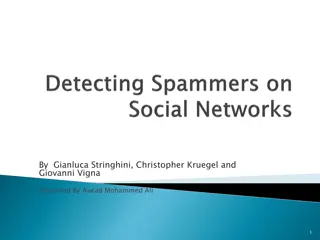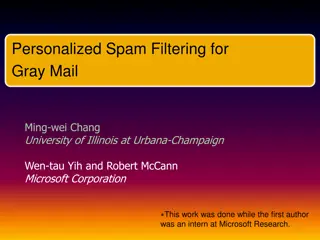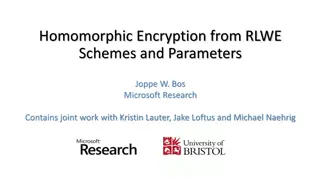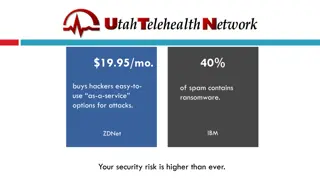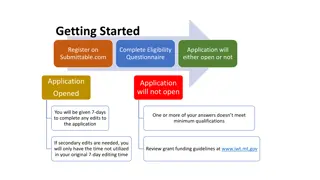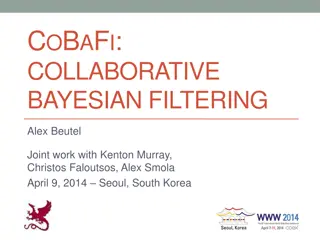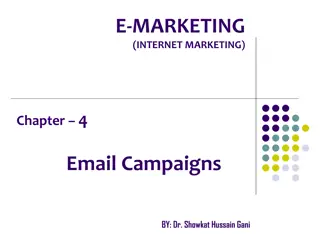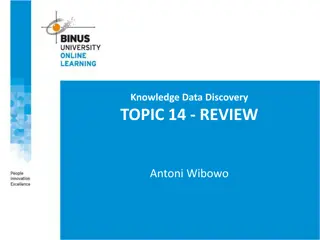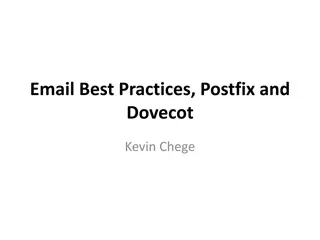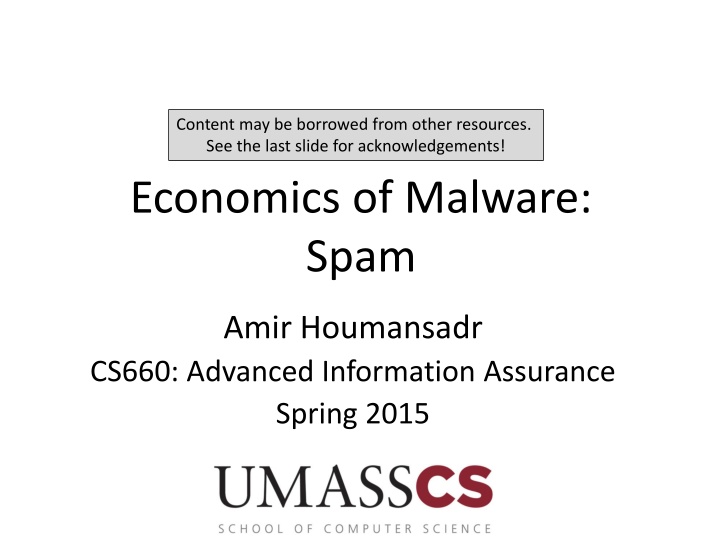
The Economics of Malware: Insights into Spam Practices
Explore the intricate world of spam, delving into the business strategies behind spam-based advertising and the complex systems involved in monetizing spam emails. Learn about the methodologies used to analyze spam data and gain a big picture view of the main components in the spam ecosystem.
Download Presentation

Please find below an Image/Link to download the presentation.
The content on the website is provided AS IS for your information and personal use only. It may not be sold, licensed, or shared on other websites without obtaining consent from the author. If you encounter any issues during the download, it is possible that the publisher has removed the file from their server.
You are allowed to download the files provided on this website for personal or commercial use, subject to the condition that they are used lawfully. All files are the property of their respective owners.
The content on the website is provided AS IS for your information and personal use only. It may not be sold, licensed, or shared on other websites without obtaining consent from the author.
E N D
Presentation Transcript
Content may be borrowed from other resources. See the last slide for acknowledgements! Economics of Malware: Spam Amir Houmansadr CS660: Advanced Information Assurance Spring 2015
Our Knowledge of Spam What do we know about spam? Annoying emails? Yahoo Mail! Spam-based advertising is a huge business While it has engendered both widespread antipathy and a multi-billion dollar anti-spam industry, it continues to exist because it fuels a profitable enterprise CS660 - Advanced Information Assurance - UMassAmherst 2
Studying Spam It is a complex system Technical: name server, email server, webpages, etc. Business: payment processing, merchant bank accounts, customer service, and fulfillment Previous work studied each of the elements in isolation dynamics of botnets, DNS fast-flux networks, Web site hosting, spam filtering, URL blacklisting, site takedown This work: quantify the full set of resources employed to monetize spam email including naming, hosting, payment and fulfillment CS660 - Advanced Information Assurance - UMassAmherst 3
Methodology Extensive measurements of three months of diverse spam data captive botnets, raw spam feeds, and feeds of spam- advertised URLs Broad crawling of naming and hosting infrastructures Over 100 purchases from spam-advertised sites Identify three popular classes of goods: pharmaceuticals, replica luxury goods, and counterfeit software CS660 - Advanced Information Assurance - UMassAmherst 4
Big Picture CS660 - Advanced Information Assurance - UMassAmherst 5
Main Parts Advertising Click support Redirect sites Third-party DNS, spammers DNS Webservers Affiliate programs Realization Payment services Fulfillment CS660 - Advanced Information Assurance - UMassAmherst 6
Data Collection and Processing CS660 - Advanced Information Assurance - UMassAmherst 7
Collect spam-advertised URLs data sources of varying types, some of which are provided by third parties, while others we collect ourselves. we focus on the URLs embedded within such email, since these are the vectors used to drive recipient traffic to particular Web sites. the bot feeds tend to be focused spam sources, while the other feeds are spam sinks comprised of a blend of spam from a variety of sources.
CS660 - Advanced Information Assurance - UMassAmherst 9
Crawler data DNS Crawler From each URL, we extract both the fully qualified domain name and the registered domain suffix. For example, if we see a domain foo.bar.co.uk we will extract both foo.bar.co.uk as well as bar.co.uk We ignore URLs with IPv4 addresses (just 0.36% of URLs) or invalidly formatted domain names, as well as duplicate domains already queried within the last day
Web Crawler The Web crawler replicates the experience It captures any application-level redirects (HTML, JavaScript, Flash) For this study we crawled nearly 15 million URLs, of which we successfully visited and downloaded correct Web content for over 6 million unreachable domains, blacklisting, etc., prevent successful crawling of many pages
Content Clustering and Tagging we exclusively focus on businesses selling three categories of spam-advertised products: pharmaceuticals, replicas, and software because they are reportedly among the most popular goods advertised in spam
Content clustering process uses a clustering tool to group together Web pages that have very similar content. The tool uses the HTML text of the crawled Web pages as the basis for clustering If the page fingerprint exceeds a similarity threshold with a cluster fingerprint Otherwise, it instantiates a new cluster with the page as its representative.
Category tagging The clusters group together URLs and domains that map to the same page content. We identify interesting clusters using generic keywords found in the page content, and we label those clusters with category tags pharma , replica , software that correspond to the goods they are selling.
Program tagging we focus entirely on clusters tagged with one of our three categories, and identify sets of distinct clusters that belong to the same affiliate program. examining the raw HTML for common implementation artifacts, and making product purchases we assigned program tags to 30 pharmaceutical, 5 software, and 10 replica programs that dominated the URLs in our feeds.
Purchasing Purchased goods being offered for sale We attempted 120 purchases, of which 76 authorized and 56 settled. Of those that settled, all but seven products were delivered. We confirmed via tracking information that two undelivered packages were sent several weeks after our mailbox lease had ended, two additional transactions received no follow-up email
Operational protocol We placed our purchases via VPN connections to IP addresses located in the geographic vicinity to the mailing addresses used. This constraint is necessary to avoid failing common fraud checks that evaluate consistency between IP-based geolocation, mailing address and the Address Verification Service (AVS) information provided through the payment card association.
Analysis Redirection 32% of crawled URLs in our data redirected at least once and of such URLs, roughly 6% did so through public URL shorteners, 9% through well- known free hosting services, 40% were to a URL ending in .html
CS660 - Advanced Information Assurance - UMassAmherst 23
Discussion With this big picture, what do you think are the most effective mechanisms to defeat spam? CS660 - Advanced Information Assurance - UMassAmherst 26
Intervention Analysis Anti-spam interventions need to be evaluated in terms of two factors: their overhead to implement their business impact on the spam value chain.
Acknowledgement Some of the slides, content, or pictures are borrowed from the following resources, and some pictures are obtained through Google search without being referenced below: MinHao Wu s slides online CS660 - Advanced Information Assurance - UMassAmherst 29

